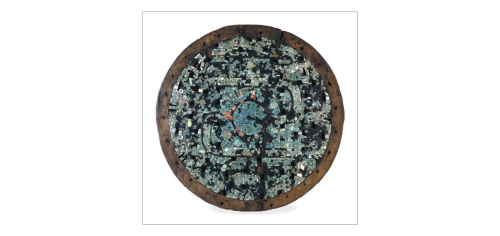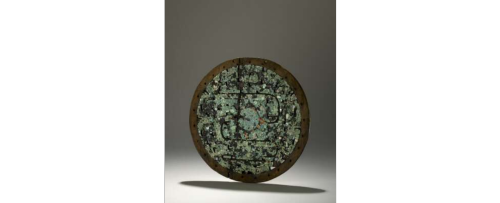shield (?); religious/ritual equipment (?); disc (?); regalia; mosaicCultures/periods: Aztec or Mi
shield (?); religious/ritual equipment (?); disc (?); regalia; mosaic Cultures/periods: Aztec or MixtecProduction date: 1400 - 1521Findspot: Mexico Provenience unknown, possibly looted Shield, or disc, with mosaic design depicting the principal divisions of the Aztec universe. Made from pine (Pinus) wood, with resin adhesive and mosaic of turquoise and three types of shell: conch (Strombus), thorny oyster (Spondylus princeps) and mother-of-pearl (Pinctada mazatlanica). Parts of the design are worked in gilded resin relief. A band of now undecorated wood around the circumference of the shield is pierced by a series of more or less regularly spaced holes, which might have been used to attach feathers to the shield. In addition, there are numerous holes in the body of the shield which from the back appear to be located at random but are in fact positioned and shaped very precisely to coincide with particular elements in the mosaic design. The mosaic design on the shield portrays the principal divisions in the Aztec universe. The overall circular shape corresponds to the surface of the earth. At its centre is a circle of mosaic with four rays still partially outlined by red Spondylus princeps and conch shell. The four rays emanating from the solar disc divide the earth into four quarters. In each quarter stands a sky bearer with eyes, teeth and ear ornaments formed of mother-of-pearl shell. The hands are represented by incised mother-of-pearl and pitted orange Spondylus shell.Solar discs feature on the design of many shields and may reflect the association between Tonatiuh, the sun, and turquoise. Tonatiuh, among the most prominent of the sky gods, was central to the cult of war, which sought to obtain captives and hearts for sacrifice to the sun. The sun was often depicted as a warrior with a rayed solar disc, and the significance of solar discs on mosaic shields probably related to the symbolism of warfare in their ceremonial use. The shield also incorporates the image of a great serpent emerging from toothed jaws and coiling skywards. The tail of the serpent is plumed on its lowermost coil and the head bears a large fang of white conch shell. The eye is made from mother-of-pearl shell and the jaw is outlined using reddish-pink Spondylus princeps and conch shell. One side of the serpent’s body is bordered by small studs of pine resin, the same resin that was used to fix the tesserae to the wood. Each of the studs was formed individually on top of the resin layer beneath and then covered by gold foil. Some of the studs retain their original foils, complete with the small falls and puckers in the gold that were inevitably formed when the flat foils were pressed over the domed studs.The body of the serpent winds sinuously upward through the design. At the top are the flowering branches of a tree, the trunk of which, hidden by a raised square ‘cartouche’, forms a vertical 'world axis’ connecting the underworld and earthly and celestial realms. The ability of snakes to move freely between water, earth and the forest canopy probably accounts for their symbolic role in Mesoamerican mythology as an intermediary between the different layers of the cosmos. At the top of the tree there is an upturned anthropomorphic mask with raised hands implying that the tree can be seen as a metaphor for the king, who derives his authority on earth from divine sources of power and who would himself have carried the shield.A feature of the shield’s design is the use of surface relief to define the various iconographical features. Careful carving of the underlying wood, in this instance Pinus sp. (pine), established not just the overall shape but also the finer, three-dimensional features of the designs such as the serpent and the sky-bearers, which were raised by about a millimetre to outline their shapes better. The technique is a characteristic of several of the turquoise mosaics and appears to have been similar to that used to define the circular bands of the Brussels shield.The holes in the body of the shield might have been used to attach feathers to it. Positioned and shaped very precisely, the holes must have been made before the mosaic work commenced, indicating that the final design was planned in detail prior to the tesserae being laid down. British Museum -- source link
Tumblr Blog : tlatollotl.tumblr.com
#archaeology#arqueologia#history#historia#mesoamerica

